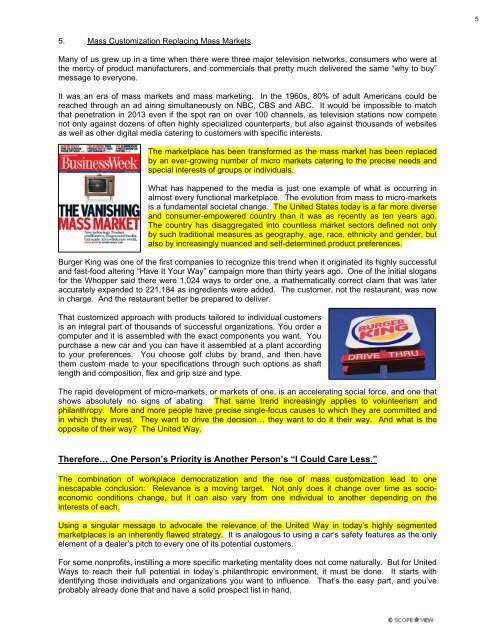Closing Session with Bill Millett â Scope View Strategic Advantage
Closing Session with Bill Millett â Scope View Strategic Advantage
Closing Session with Bill Millett â Scope View Strategic Advantage
You also want an ePaper? Increase the reach of your titles
YUMPU automatically turns print PDFs into web optimized ePapers that Google loves.
55. Mass Customization Replacing Mass Markets.Many of us grew up in a time when there were three major television networks, consumers who were atthe mercy of product manufacturers, and commercials that pretty much delivered the same “why to buy”message to everyone.It was an era of mass markets and mass marketing. In the 1960s, 80% of adult Americans could bereached through an ad airing simultaneously on NBC, CBS and ABC. It would be impossible to matchthat penetration in 2013 even if the spot ran on over 100 channels, as television stations now competenot only against dozens of often highly specialized counterparts, but also against thousands of websitesas well as other digital media catering to customers <strong>with</strong> specific interests.The marketplace has been transformed as the mass market has been replacedby an ever-growing number of micro markets catering to the precise needs andspecial interests of groups or individuals.What has happened to the media is just one example of what is occurring inalmost every functional marketplace. The evolution from mass to micro-marketsis a fundamental societal change. The United States today is a far more diverseand consumer-empowered country than it was as recently as ten years ago.The country has disaggregated into countless market sectors defined not onlyby such traditional measures as geography, age, race, ethnicity and gender, butalso by increasingly nuanced and self-determined product preferences.Burger King was one of the first companies to recognize this trend when it originated its highly successfuland fast-food altering “Have It Your Way” campaign more than thirty years ago. One of the initial slogansfor the Whopper said there were 1,024 ways to order one, a mathematically correct claim that was lateraccurately expanded to 221,184 as ingredients were added. The customer, not the restaurant, was nowin charge. And the restaurant better be prepared to deliver.That customized approach <strong>with</strong> products tailored to individual customersis an integral part of thousands of successful organizations. You order acomputer and it is assembled <strong>with</strong> the exact components you want. Youpurchase a new car and you can have it assembled at a plant accordingto your preferences. You choose golf clubs by brand, and then havethem custom made to your specifications through such options as shaftlength and composition, flex and grip size and type.The rapid development of micro-markets, or markets of one, is an accelerating social force, and one thatshows absolutely no signs of abating. That same trend increasingly applies to volunteerism andphilanthropy. More and more people have precise single-focus causes to which they are committed andin which they invest. They want to drive the decision… they want to do it their way. And what is theopposite of their way? The United Way.Therefore… One Person’s Priority is Another Person’s “I Could Care Less.”The combination of workplace democratization and the rise of mass customization lead to oneinescapable conclusion: Relevance is a moving target. Not only does it change over time as socioeconomicconditions change, but it can also vary from one individual to another depending on theinterests of each.Using a singular message to advocate the relevance of the United Way in today’s highly segmentedmarketplaces is an inherently flawed strategy. It is analogous to using a car’s safety features as the onlyelement of a dealer’s pitch to every one of its potential customers.For some nonprofits, instilling a more specific marketing mentality does not come naturally. But for UnitedWays to reach their full potential in today’s philanthropic environment, it must be done. It starts <strong>with</strong>identifying those individuals and organizations you want to influence. That’s the easy part, and you’veprobably already done that and have a solid prospect list in hand.©


